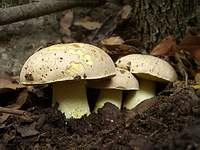Semi-porcini mushroom (Hemileccinum impolitum)
- Vaega: Basidiomycota (Basidiomycetes)
- Vaevaega: Agaricomycotina (Agaricomycetes)
- Vasega: Agaricomycetes (Agaricomycetes)
- Vasega laiti: Agaricomycetidae (Agaricomycetes)
- Poloaiga: Boletales (Boletales)
- Aiga: Boletaceae (Boletaceae)
- Tootoo: Hemileccinum
- ituaiga: Hemileccinum impolitum (Semi-white mushroom)
 The recent revision by mycologists of the Boletaceae family has led to the fact that some species have migrated from one genus to another, and many have even acquired a new – their own – genus. The latter occurred with a semi-white mushroom, which was previously part of the genus Boletus (Boletus), and now bears a new “surname” Hemileccinum.
The recent revision by mycologists of the Boletaceae family has led to the fact that some species have migrated from one genus to another, and many have even acquired a new – their own – genus. The latter occurred with a semi-white mushroom, which was previously part of the genus Boletus (Boletus), and now bears a new “surname” Hemileccinum.
faamatalaga:
The cap is 5-20 cm in diameter, convex in young mushrooms, then cushion-shaped or prostrate. The skin is velvety at first, then smooth. The color is clayey with a reddish tint or light gray with an olive tint.
The tubules are free, golden yellow or pale yellow, becoming greenish yellow with age, do not change color or slightly darken (do not turn blue) when pressed. The pores are small, angular-rounded.
Spore powder is olive-ocher, spores are 10-14*4.5-5.5 microns in size.
Leg 6-10 cm high, 3-6 cm in diameter, squat, first tuberous-swollen, then cylindrical, fibrous, slightly rough. Yellow at the top, dark brown at the base, sometimes with a reddish band or spots, without reticulation.
The flesh is thick, pale yellow, intensely yellow near the tubules and in the stem. Basically, the color on the cut does not change, but sometimes there is a very slight pinking or blue after a while. The taste is sweetish, the smell is slightly carbolic, especially at the base of the stem.
Faʻasalalau:
A heat-loving species, found in coniferous forests, as well as under oak, beech, in the South often in beech-hornbeam forests with dogwood undergrowth. Prefers calcareous soils. Fruits from late May to autumn. The mushroom is quite rare, fruiting is not annual, but sometimes plentiful.
Le tutusa:
Inexperienced mushroom pickers may confuse with porcini mushroom (Boletus edulis), with girl’s boletus (Boletus appendiculatus). It differs from them in the smell of carbolic acid and the color of the pulp. There is a risk of confusion with the inedible deep-rooted boletus (Boletus radicans, syn: Boletus albidus), which has a light gray cap, lemon yellow stem and pores that turn blue when pressed, and is bitter in taste.
Iloiloga:
Mushroom is very tasty, the unpleasant smell disappears when boiled. When pickled, it is not inferior to white, has a very attractive light golden color.









